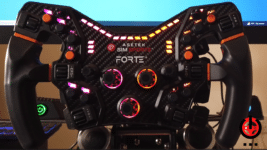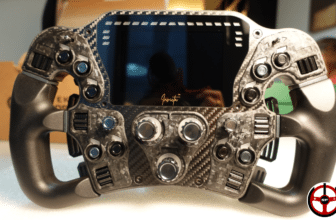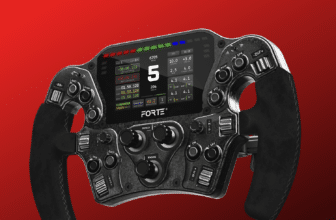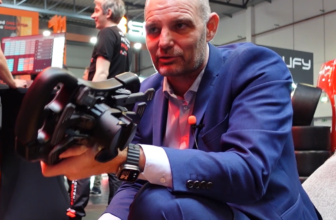Should you go for the Asetek Forte Formula steering wheel? This is an important question for all potential buyers of Asetek SimSports bases. The Danish brand has certainly covered its tracks. It has signed 7 partnerships with steering wheel manufacturers to offer the widest range of compatible steering wheels on the simracing market. BUT all these wheels are very high-end models, costing well over €1,000.
So what’s the alternative? Well, the Forte Formula Wheel designed by Asetek, priced from €650 (incl. VAT). So what does it actually do on the track? Let’s find out in this test!
What does the Asetek Forte Formula look like in technical terms?

- Diameter: 29cm (with Meduim grips)
- Materials: Carbon, plastic, metal, composite including carbon fiber and fiberglass.
- Grips: Non-slip, anti-transpirant molded silicone. Interchangeable.
- Paddles: 2 magnetic paddles for shifting gears
- Customizable buttons: 12 customizable buttons, each associated with an RGB LED. 2 2-position switches. 2 switches 7 positions.
- Rotary encoders: 3 rotary encoders on the center plate, each encircled by a configurable RGB LED. 6 thumb-operated rotary selectors (3 on each side).
- Lap counter: 15 configurable LEDs
- Flag display: 6 LEDs (3 on each side)
- Display: No
- Quick Release: Asetek model under Simucube license
- Compatibility: Asetek bases (QR not removable)
Ergonomics and design
Out of the box, the first thing you notice is the finish. The front of the wheel is covered with a 2mm-thick carbon fiber plate. But what really catches my eye is the steering wheel shell. It’s made from a blend of carbon fiber, fiberglass and plastic, among other materials. The result is somewhat reminiscent of forged carbon plates, but with a more matt, “rough” feel under the finger.
In the box :
- Asetek Forte Formula Wheel
- 2 sheets of stickers to customize the RGBs on the steering wheel
- Antistatic carbon-fiber tweezers for applying stickers
- QR code for online instructions
As for the design, you’ll tell me that it’s obviously a matter of taste, but for me it wasn’t love at first sight. This is certainly partly due to the 3 rotary encoders in the center of the wheel, which are very prominent and have a plastic finish.
However, the other thing that jumps out at me is, of course, the astronomical number of buttons and selectors. Quite simply, I counted no less than 80 different functions, not including options and not counting the LED displays. 80 functions might seem a bit much. But in reality, if you drive different types of vehicles, such as GTs then LMPs then Formula cars, you’ll be more than happy not to have to change your key settings between races.
At the rear, you’ll find two magnetic paddles that can be lengthened or shortened with a turn of the Allen key. There are also slots for optional clutch and DRS paddles, for example.
Installing the wheel on an Asetek chainstay

To fit the wheel on the base, we’re finally going to have the pleasure of using the Asetek Quick Release. Simply slide the V at the rear of the wheel’s QR onto the steering shaft from above. That’s all there is to it! Your steering wheel is connected and ready to use.
To remove it, I press the lever on the back of the steering wheel and slide the wheel up. This can be done with one hand, without the slightest friction. Of all the Quick Releases I’ve tested to date, this is by far the most practical I’ve come across.
The connection between the wheel and the base is made via 6 spring-loaded pins. These 6 pins supply the wheel with electricity and also serve to transfer information. So there are no Wifi/Vlan/Bluetooth/etc waves on Asetek models. Everything is done via physical connections for faster data transfer.
Configuring the steering wheel on RaceHub software
Now that the steering wheel has been installed and its LEDs illuminated, it’s time to configure it using the RaceHub software. Here again, everything is very comprehensive. Each LED can be configured individually. But you can also create groups of LEDs and modify them simultaneously with just a few clicks. So I’m having fun customizing the colors of each LED that backlights the stickers I’ve placed on the slots above each button.
You can also have fun customizing the 15 LED lap counters with all the options imaginable. Personally, I leave them as they are. Oh, and for those wondering, yes, you can turn off all the LEDs if they bother you.
To find out more: force feedback settings on RaceHub
Comfort and feel
Once on the track, the Asetek Forte Formula finally reveals all its talents. If I had trouble with its aesthetics, I have to admit that once out on the track, it’s a real pleasure to ride. All the buttons fall easily to hand, and the 6 thumb-level rotary selectors are all accessible without taking your hands off the wheel. In the end, it’s only the three large selectors in the center of the steering wheel that I have to let go of one hand.
Button clicks are straightforward and I didn’t miss a thing. The rotary knobs in the center are also straightforward and pleasant. However, I would have appreciated it if the thumbwheels had been more straightforward, and if they couldn’t have been left “in between” positions. So, to clarify, you really have to want it to leave the selector between two positions, but it’s possible and it’s one of the details I’m looking at at this price level. As for the paddles, they do the job perfectly, almost noiselessly and without misfiring.
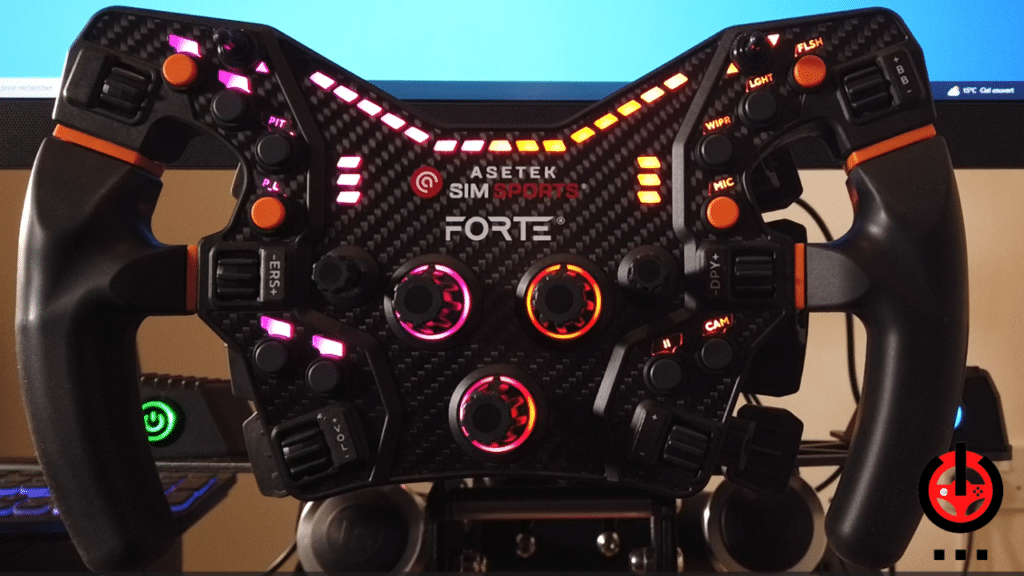
I’m also very happy with the diameter of the wheel. 29cm allows for great versatility in Formula, LMP or GT. But above all, I’m delighted with the Forte Formula’s rigidity. No matter how hard I tried for 3 weeks with the Invicta base, then for two weeks with the Forte base, it just wouldn’t play. In short, a great success from Asetek, for whom, I remind you, this is their very first steering wheel!
Customizing the Asetek Forte Formula Wheel
There’s a lot to customize on this wheel. The first thing to do, of course, is to position the stickers on the button LEDs and change the color to make your wheel sexier and more practical.
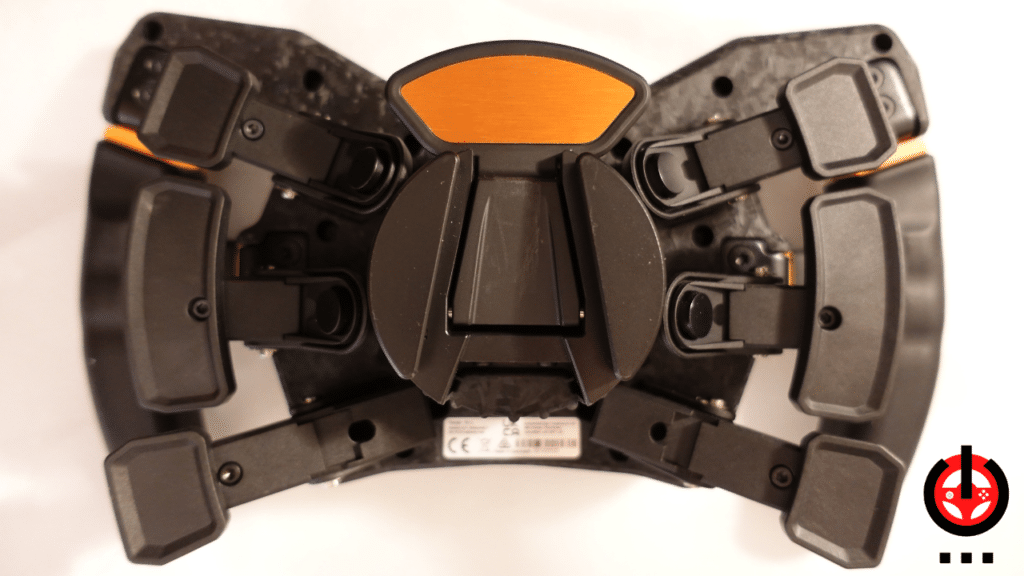
Then there are the options to be purchased separately, such as the magnetic paddles to be positioned above the gearshift paddles. These paddles can be used to activate DRS and Push to Pass , for example.
Then there’s a clutch paddle kit. These two magnetic sensor paddles can be used in combination to make a Double Clutch. Or as individual shafts, or even as simple “buttons”. In short, you can do what you like with them..
And finally, you can change handles. As standard, the Forte Formula steering wheel comes with Medium silicone grips. But Asetek will soon be offering other sizes, hardnesses and shapes to suit everyone. And it would be no surprise if, in the coming months, private individuals or small accessory brands were to offer kits for changing your handles, with even more varied choices.

